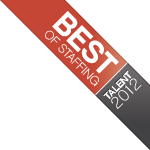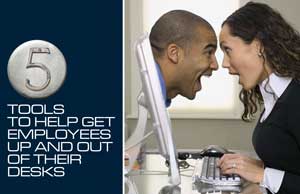5 Tools to Help Get Employees Up and Out of Their Desks
|
 |
 We know prolonged sitting is detrimental to individual and business health.
We know prolonged sitting is detrimental to individual and business health.
Prolonged sitting decreases productivity and creativity and ratchets up stress. Research now links prolonged sitting to more extreme health risks, such as obesity, Alzheimer's, diabetes and heart disease, and even an earlier death.
The research is telling us: We need to unseat employees. But how? Until dance walking through the office becomes the norm, we're going to need some help.
I collected a handful of tools employees can use to unseat themselves throughout the day, including one designed and developed by my firm. Of all of these, I've only tested Hotseat and Fitbolt. (Warning: self-promotion. Hotseat is a product from context.)
1. Hotseat
Hotseat is a new health app from context, a change management and communication consulting firm that specializes in wellness. Hotseat uses social accountability, gameful design and our extreme attachment to our smartphones to unseat employees.
Employees start by choosing activities that interest them and meet their desired intensity level. Working with each employee's calendar availability to make sure there are no conflicts, Hotseat sets up a daily roster of two-minute activity breaks and nudges employees to complete them.
Employees can take their breaks solo, or they can create collaborative and competitive challenges to make the breaks social and fun. Hotseat is available for iPhone with an Android version coming soon.
2. Fitbolt
Fitbolt is the product of Evan Carothers, a software developer.
Fitbolt sits on your browser or desktop and alerts you every 30 minutes to take a fitness break, pulling from a catalog of stretches and exercises. Its algorithm tracks what exercises you like and pushes out new activities based on your preferences.
Premium members receive health reminders and diet pointers as well as tips about improving posture and work ergonomics. Fitbolt integrates with other popular personal health trackers, such as Fitbit, Runkeeper and Dailymile, and has recently issued an open invitation to employers interested in deploying Fitbolt company-wide.
3. Instant Recess
Instant Recess is the brainchild of Dr. Toni Yancey, a professor at UCLA's School of Public Health.
Since 1999, Dr. Yancey's advocated for bringing playground recess into the workplace through her book and partnerships. The idea is simple: create structured activity breaks throughout the day and invite all employees to participate. The length, frequency and style of the break is something you build over time and customize to your culture.
One company using instant recess implemented five-minute breaks three times per day. Another set up 10-minute stretch breaks every morning and afternoon. Similarly, the break approach is up to each company's interpretation.
Your company wants to line dance during its 10-minute break? Then shake it. You have a more sedate culture? No problem, you can do walking meetings.
4. Workpace
Workpace isn't focused on reducing sedentary behavior, but it does prompt employees to get up and move.
Workpace bills itself as a health and safety tool focused on injury prevention brought on by computer overuse. Workpace tracks computer use to detect patterns and alerts employees when they need to take a break. Breaks may be small--a micropause--or a bit longer, a workpace break. The Workpace break functions as an activity break, as you need to get up and move.
Typically, Workpace only interrupts users if they don't take natural breaks, and the default setting is a five-minute break after every 55 minutes of continuous PC use. Companies using workpace can pick and choose their settings and apply different settings to different work groups.
5. Dogs, the sedentary employee's best friend
Another new Virginia Commonwealth University study finds that bringing dogs to work may lower employee stress.
Yes, dogs at work will certainly get employees out of their seats--whether it's to play fetch or to scramble to keep the carpet in the conference room stain-free.





